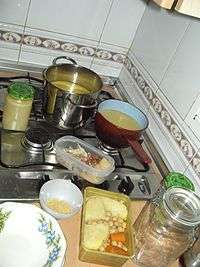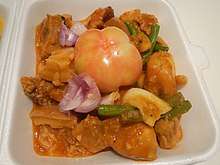Puchero
Puchero is a type of stew originally from Spain, prepared in Yucatán, Mexico, Argentina,[1] Paraguay, Uruguay, Perú, south of Brazil, the Philippines, and Spain, specifically the autonomous communities of Andalusia and the Canary Islands. The name comes from the Spanish word "puchero" which means "stewpot".
 | |
| Course | Main course |
|---|---|
| Place of origin | Spain |
| Main ingredients | Varies by region |
| 5 kcal (21 kJ) | |
The dish is essentially equivalent to the cocido of Spain but lacking colorants (such as paprika), using local ingredients which vary from one region to another. In Spain chickpeas are widely used. A dish similar to puchero called sancocho is consumed in Colombia, Ecuador, República Dominicana, Venezuela and Puerto Rico.
Andalusian puchero
In Andalusia, puchero was originally a peasant soup. The basic ingredients of the broth are meat (beef, veal, pork and/or chicken), bacon, cured bones (such as those of the jamón serrano), and vegetables (potatoes, celery, chard, leek, carrots, and turnips). It can be drunk straight in mugs as a consommé known as caldo de puchero, which can be seasoned with fresh spearmint leaves or sherry. Alternatively, it can be prepared as a soup after adding chickpeas, cured ham, boiled egg, and rice, noodles or bread. The meat left-overs, called pringá, is usually served separately as a main dish, and the remnants used for subsequent dishes as croquettes or ropa vieja.
Río de la Plata puchero
Puchero is eaten in the parts of Argentina, Uruguay, and Paraguay that border the Río de la Plata. The dish is prepared quite similarly as in Spain, though its ingredients are significantly different due to the vastly different local produce. In the parts of Argentina, Paraguay and Uruguay surrounding the estuary of the Río de la Plata, puchero is primarily beef-based, as beef was plentiful and cheap, and chickpeas are less common there than in the Iberian peninsula. The resulting broth is often drank alongside it.
The cuts of meat used are particularly important: if possible, ossobuco; otherwise beef cuts with marrow or poultry (used in puchero de gallina) can be substituted. Other ingredients used may include potatoes, onions, and squash. Some local variations call for the addition of sweet potatoes,[1] sweet corn, carrots, bacon, sliced chorizo, pork belly, cabbage, and eggs.
Puchero is considered a lower- and middle class staple, and is traditionally served during the fall and winter. It can be found on menus in family and regional restaurants throughout Argentina, but not at most more expensive restaurants.[1]
Philippine puchero

In Philippine cuisine, puchero (Spanish: Pochero; Tagalog: putsero) refers to a dish composed of beef chunks stewed with saba bananas (or plantains). The dish may also include potatoes or sweet potatoes, chorizos de Bilbao, bok choy, leeks, chickpeas, cabbage and tomato sauce. Other versions replace beef with chicken or pork.
Yucatec puchero
The Yucatec puchero varies by cook and region. The most complete version is called puchero de tres carnes -- "with three meats", pork, beef and chicken. This could actually be a great vegetarian dish if made without the meat as the other ingredients include: a piece of plantain in skin, onion, potatoes, sweet potatoes, carrots, squash /calabaza, turnips or parsnips (when and where available), white cabbage /repollo and typically a type of pasta soup (noodles/fideos) and rice to increase the heartiness and especially if only one or two meats are used. The soup like the 98% of Yucatec soups-stews are broth consommés, not at all thick or heavy. It is flavored with saffron, allspice and black pepper. The dish is served with all ingredientts in the bowl and a side of fresh additions. Typically or traditionally, a side plate is provided so that the person can put the meat to the side while eating the soup. The garnish consists of freshly chopped or diced habanero, onion, radish and cilantro. Avocados when in season. See Steffan Igor Ayora Diaz book on the anthropology of Yucatán food [2]
See also

References
- "Sabores argentinos: el puchero" (in Spanish). April 20, 2010. Archived from the original on April 29, 2012. Retrieved 2011-03-07.
- Ayora-Diaz, Steffan Igor (2012) Foodscapes, Foodfields and Identities in Yucatán. Amsterdam: CEDLA, New York: Berghahn